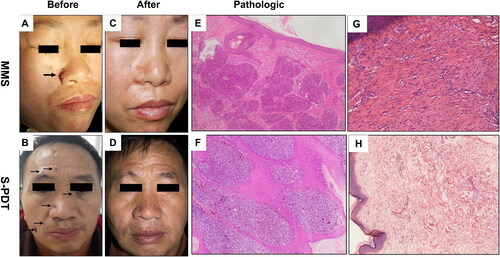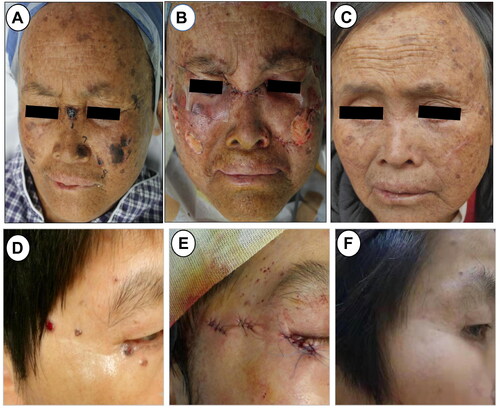Figures & data
Figure 1. The procedures of S-PDT. (A) Routine disinfection towels and local lidocaine anesthesia. (B) Superficial shaving with a scalpel or razor. (C) Electrocoagulation was used to stop bleeding. (D)Apply pressure dressing with gauze, sterile gloves, cotton pads, or bandages. (E) Red light with wavelength of 633 nm and power of 80mW/cm2 was irradiated for 20 min. (F) Good postoperative recovery at 36 months follow-up.

Figure 2. Clinical and pathology pictures in MMS and S-PDT groups. (A,B) Clinical picture with one lesion before treatment and 12 mouth follow-up in MMS group. (C,D) Clinical picture with four lesions before treatment and 12 mouth follow-up in S-PDT group. (E,F) Pathology before treatment in both groups shows basal cell carcinomas with basal cell-like cell hyperplasia, cytoplasm, deep staining of the nucleus, nucleus, disordered arrangement (hematoxylin–eosin stain, original magnification ×100). (G) Pathological biopsies after 1 year of follow-up in MMS group and show scar tissue. (F) Pathological biopsies after 2 years of follow-up in S-PDT group and show scar tissue and no recurrent pathological features.

Table 1. Baseline characteristics in the S-PDT and MMS group.
Table 2. Therapeutic effects, DLQI and total treatment time.
Table 3. Cosmetic response to S-PDT and MMS at 12 months after treatment.
Table 4. Total costs both in S-PDT and MMS group (Euro).
Figure 3. Clinical picture of two patients in S-PDT group. (A) Multiple basal cell carcinomas of the facial ministry in a 52-year-old woman. (B) Clinical photograph immediately after superficial shaving treatment. (C) Clinical photograph after a follow-up of 12 months. (D)Basal cell carcinoma of the right eye periphery in a 56-year-old woman. (E) Clinical photograph after simple excision and suturing. (F) Clinical photograph after a follow-up of 24 months.

Supplemental Material
Download PDF (371.8 KB)Data availability statement
The data that support the findings of this study are available on request from the corresponding author. The data are not publicly available due to privacy or ethical restrictions.
